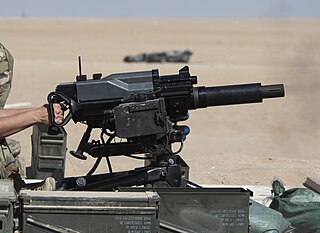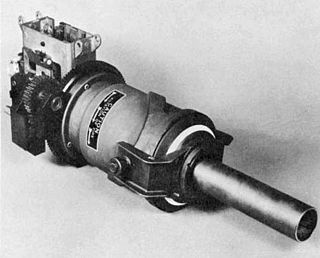
The M61 Vulcan is a hydraulically, electrically, or pneumatically driven, six-barrel, air-cooled, electrically fired Gatling-style rotary cannon which fires 20 mm × 102 mm rounds at an extremely high rate. The M61 and its derivatives have been the principal cannon armament of United States military fixed-wing aircraft for over sixty years.

A grenade launcher is a weapon that fires a specially designed, large-caliber projectile, often with an explosive, smoke, or gas warhead. Today, the term generally refers to a class of dedicated firearms firing unitary grenade cartridges. The most common type are man-portable, shoulder-fired weapons issued to individuals, although larger crew-served launchers are issued at higher levels of organization by military forces.

The M203 is a single-shot 40 mm under-barrel grenade launcher designed to attach to a rifle. It uses the same rounds as the older stand-alone M79 break-action grenade launcher, which utilizes the high-low propulsion system to keep recoil forces low. Quite versatile and compatible with many rifle models, the M203 was originally designed for the U.S. M16 and its carbine variant, the M4. The launcher can also be mounted onto a C7, a Canadian version of the M16 rifle; however, this requires the prior removal of the bottom handguard.

A chain gun is a type of autocannon or machine gun that uses an external source of power to cycle the weapon's action. Rather than diverting excess energy from the cartridges' propellant as in a typical automatic firearm, it is powered by a continuous loop of chain similar to that used on a motorcycle or bicycle.
The M134 Minigun is an American 7.62×51mm NATO six-barrel rotary machine gun with a high rate of fire. It features a Gatling-style rotating barrel assembly with an external power source, normally an electric motor. The "Mini" in the name is in comparison to larger-caliber designs that use a rotary barrel design, such as General Electric's earlier 20 mm M61 Vulcan, and "gun" for the use of rifle ammunition as opposed to autocannon shells.

The M39 cannon is a 20 mm caliber single-barreled revolver cannon developed for the United States Air Force in the late 1940s. It was used on a number of fighter aircraft from the early 1950s through the 1980s.

M320 Grenade Launcher Module (GLM) is the U.S. military's designation for a new single-shot 40 mm grenade launcher system to replace the M203 for the U.S. Army, while other services initially kept using the older M203. The M320 uses the same High-Low Propulsion System as the M203.

The United States military has developed a number of Helicopter Armament Subsystems since the early 1960s. These systems are used for offensive and defensive purposes and make use of a wide variety of weapon types including, but not limited to machine guns, grenade launchers, autocannon, and rockets. Various systems are still in use, though many have become obsolete.

The Mk 47 or Striker 40 is a 40mm automatic grenade launcher with an integrated fire control system, capable of launching smart programmable 40mm air burst grenades in addition to various unguided rounds.

The XM307 Advanced Crew Served Weapon (ACSW) was a developmental 25 mm belt-fed automatic grenade launcher with programmable airburst capability. It is the result of the OCSW or Objective Crew Served Weapon project. It is lightweight and designed to be two-man portable, as well as vehicle mounted. The XM307 can kill or suppress enemy combatants out to 2,000 meters (2,187 yd), and destroy lightly armored vehicles, watercraft, and helicopters at 1,000 meters (1,094 yd). The project was canceled in 2007.

The United States Armed Forces has created a plethora of different types of 40 mm grenades in both the low-velocity 40×46 mm and high-velocity 40×53 mm calibers which uses what it calls a high-low propulsion system which keeps recoil forces within the boundaries of an infantry weapon. Presented on this page is a basic overview.

The vortex ring gun is an experimental non-lethal weapon for crowd control that uses high-energy vortex rings of gas to knock down people or spray them with marking ink or other chemicals.
The 37 mm Automatic Gun, M4, known as the T9 during development, was a 37 mm (1.46 in) recoil-operated autocannon designed by Browning Arms Company. The weapon, which was built by Colt, entered service in 1942. It was primarily mounted in the Bell P-39 Airacobra and P-63 Kingcobra, with the U.S. Navy also utilizing it on many PT boats.

An armed helicopter is a military helicopter equipped with aircraft ordnance. Most commonly, it is used for attacking targets on the ground. Such a helicopter could be either purposely designed for a ground-attack mission—in which case it would be more specifically categorized as an attack helicopter—or may have been previously designed for other uses, such as utility, air cargo, aerial reconnaissance, etc., with the weapons mounts being modifications, rather than part of the design of the helicopter. The purpose of the modification to an armed helicopter configuration can be field expediency during combat, the lack of military funding to develop or purchase attack helicopters, or the need to maintain the helicopter for missions that do not require the weapons.

The M129 is a 40 mm automatic grenade launcher that was used as an aircraft weapon in United States service. It was developed from the earlier M75 and was capable of using both the high-velocity 40x53 mm grenade and the lower velocity 40x46 mm grenade.

Ordnance Factory Tiruchirappalli (OFT), also called Ordnance Factory Trichy, is a small arms factory operated by Advanced Weapons and Equipment India Limited based in Tiruchirappalli, Tamil Nadu, which was previously part of Ordnance Factory Board of the Ministry of Defence, Government of India. The company is headed only by an IOFS officer called General Manager (ex officio Additional Secretary to Government of India) who is the Chief Executive Officer, responsible for the overall management of the company. OFT is the largest small arms manufacturing company of India and has the most varied range.














